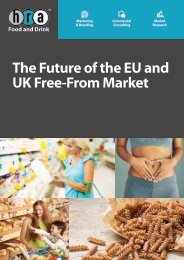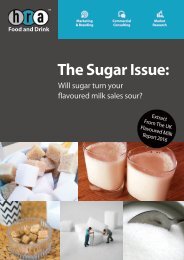Flavoured_Milk_Free
The backdrop to the UK flavoured milk market is one of relentless change. The removal of the EU milk quotas, the transition by emerging economies to a Western-style diet, the upcoming introduction of the ‘sugar tax’ and the booming sports nutrition industry are all aspects of change that create both challenges and opportunities for the UK flavoured milk market. HRA Food and Drink has developed this report as a map to guide industry stakeholders. Although volume growth in 2014 was slightly lower than in previous years, the flavoured milk market still has plenty of room for product innovation in the future.
The backdrop to the UK flavoured milk market is one of relentless change. The removal of the EU milk quotas, the transition by emerging economies to a Western-style diet, the upcoming introduction of the ‘sugar tax’ and the booming sports nutrition industry are all aspects of change that create both challenges and opportunities for the UK flavoured milk market.
HRA Food and Drink has developed this report as a map to guide industry stakeholders. Although volume growth in 2014 was slightly lower than in previous years, the flavoured milk market still has plenty of room for product innovation in the future.
You also want an ePaper? Increase the reach of your titles
YUMPU automatically turns print PDFs into web optimized ePapers that Google loves.
UK FLAVOURED MILK MARKET 2017 & BEYOND<br />
8.1 Political: UK ‘Sugar Tax’<br />
Of all the future challenges, sugar is a very significant issue that the flavoured milk industry<br />
will have to deal with over the next decade.<br />
Sugar is an integral part of the flavoured milk product, which is ordinarily comprised of<br />
milk, sugar and flavourings. However, high-profile celebrity endorsed campaigns and<br />
government led initiatives are beginning to turn the tide on sugar. A 2015 report published<br />
by Public Health UK entitled ‘Sugar reduction: from evidence into action’ calling for a tax<br />
on high sugar foods sparked opposition within the food and drink industry, who cited a lack<br />
of evidence that the tax would be effective.<br />
Cost of<br />
obesity<br />
Obesity-related health issues are costing the NHS<br />
approximately £5.1 billion each year. (NICE 2013)<br />
Prevalence of<br />
obesity<br />
International<br />
evidence<br />
In 2015, 25% of adults, 10% of 4 to 5 year olds and<br />
19% of 10 to 11 year olds were obese. (HSCIC 2015)<br />
To view please<br />
purchase full report<br />
A sugary drink tax in Mexico led to a 12% increase in<br />
sales of sugar-free drinks after one year. (Colchero<br />
2016)<br />
Opinion of<br />
NHS<br />
Figure 8.2: The case for the UK sugar tax<br />
Head of NHS England says that a sugar tax of 10% to<br />
20% could be effective in saving lives.<br />
-free drinks after one year (BMJ 2016)<br />
In March 2016, the then Chancellor George Osbourne announced a tax on soft drinks,<br />
which will come into force in 2018. Figure 8.3 details how this drinks tax will work. <strong>Milk</strong>based<br />
drinks are exempt from the tax, meaning at present there is no direct impact upon<br />
the flavoured milk industry. However, the tax illustrates a general trend towards low-sugar<br />
drinks, which may affect consumer sales, and flavoured milk manufacturers may want to<br />
voluntarily respond to these signals.<br />
138<br />
© 2016 Teepee Limited. All Rights Reserved.







